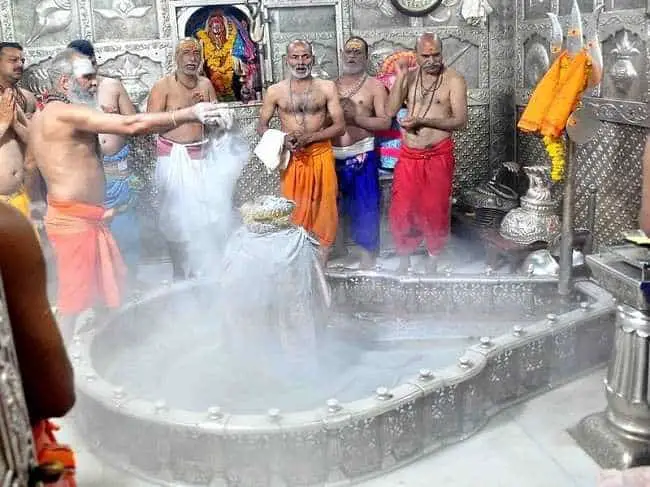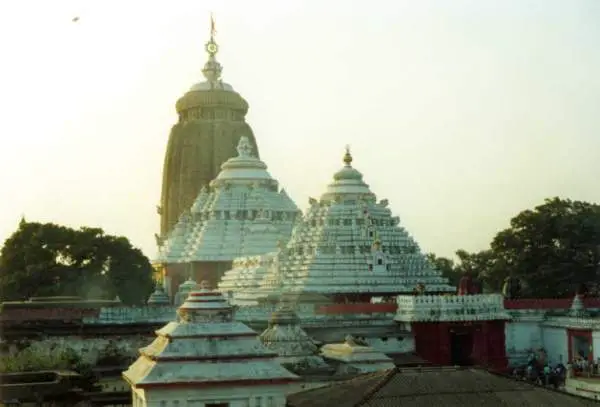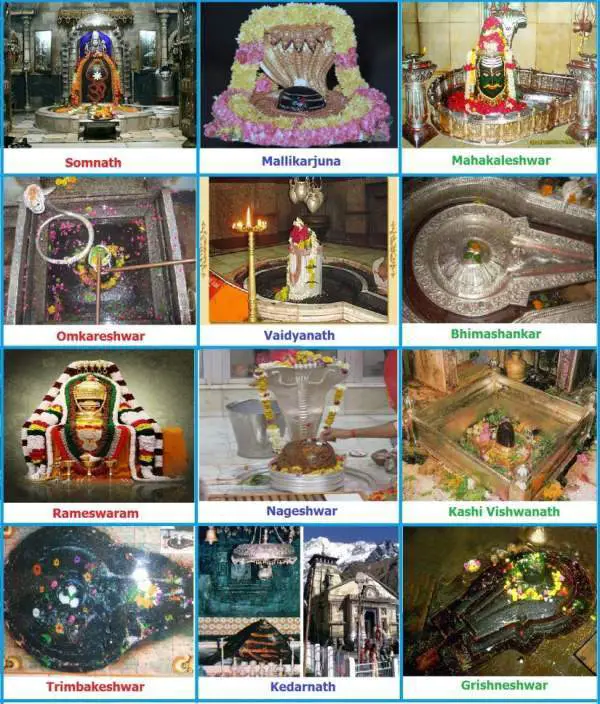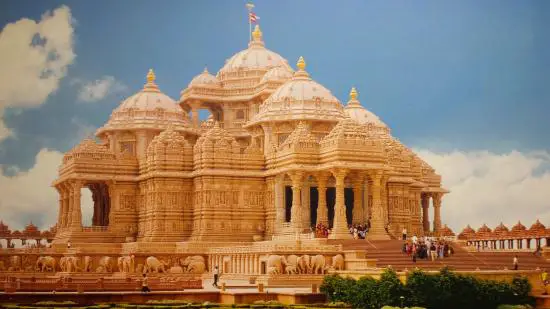Mahakaleshwar Jyotirlinga Temple, Ujjain, is dedicated to Hindu God Shiva. It is one of the 12 Jyotirlingams, which means it is one of the most sacred abodes of Bhagwan Shiv. The Mahakaleshwar temple is in Ujjain in the state of Madhya Pradesh, India.
There is a holy river Shipra on the bank of which this temple lies. Mahakaleshwar means the lord of time, and people believe that Lord Shiva is the lord of time.
It is also believed that the Shiva Lingam in the Mahakaleshwar temple is ‘self-manifested, ‘ meaning that it obtains its power from within itself. This is in contrast with the other lingams or images where the deities are established spiritually, and the energy is invoked through Mantras (prayers).

Table of Contents
History of Mahakaleshwar Jyotirlinga
The original structure of the Mahakaleshwar temple was destroyed by Sultan-Shams-ud-din Iltutmish during his raid of Ujjain that occurred in 1234-1235.
The original Jyotirlinga was demolished and thrown into “Kotiteerth Kunda,” a pond neighboring the temple.
The Jaladhari, the pot holding the water that continuously dropped on the Shiva Lingam and supported the idol, was stolen.
The Marathas built the current structure of the Mahakaleshwar temple and the visible deity. It was built again by Ranoji Shinde in 1734 CE. He built this after Baji Rao appointed him as the tax collector of the Marwa region.
It was Jayajiroa Shinde under whose reign prominent functions and celebrations of the Gwalior state were held at this temple.
The regime of the Maratha Empire was established in Ujjain in the 4th decade of the 18th century. Ranoji Shinde was a loyal and competent commander of Peshwa Bajirao and therefore was assigned to Ujjain’s administration.
Sukhatanakar Ramchandra Baba Shenavi, Diwan of Ranoji, was an affluent person and decided to donate his wealth to religious causes.
With his intention, the Mahakaleshwar temple was re-constructed during the 4th-5th decade of the 18th century.
After the Independence of India in 1947, the temple came under the administration of the municipal corporation of Ujjain from Mahakaleshwar Dev Sthan Trust.
About the Jyotirlingas
Once, according to the Shiva Purana, Brahma and Shri Vishnu disagreed on who was more powerful among them. So, to test them and see who was mightier, Bhagwan Shiva pierced the three worlds as an endless pillar made of light. This was the Jyotirlinga.
Both Brahma and Vishnu decided to find the starting and end of the pillar of light. Shri Vishnu took the form of wild boar and went down to find the starting of the pillar, while Brahma took the form of a swan and flew up to find the end of the pillar.
However, Brahma lied about having found the end of the pillar and offered Shiva a Ketaki flower as the witness. But in contrast to Brahma, Vishnu conceded his failure to find the pillar’s start.
After this, Shiva appeared as the second pillar of light, and Brahma, the creator, was cursed that he would not be worshipped in any of the ceremonies. At the same time, Vishnu would hold the same position as Shiva till the end of eternity.
The Jyotirlinga is the supreme partless reality, and Shiva partly appears out of it.
And all the 12 Jyotirlingas are where Shiva appeared as the column of light. So just like Mahakaleshwar jyotirlinga, all the jyotirlingas are the manifestation of Lord Shiva.
All the images of lingams represent the infinite nature of Lord Shiva.
The Mahakaleshwar Jyotirlinga Temple
As you already know, there are 12 jyotirlingas in India, and the Mahakaleshwar temple is the only one with a Dakshinamukhi Shiva Lingam. Dakshin means South, and Mukhi means facing, which means South-facing idol.
South is also considered by legends as the direction of death.
The main deity of Omkareshwar Mahadev is consecrated in the temple’s Sanctum Sanctorum, which lies above the shrine of Mahakal.
In the Sanctum are images of Goddess Parvati, Shiva’s consort, Lord Ganesh, and Kartikey installed on the east, west, and the north side of the temple.
In the South of the temple, there is the image of Nandi, who is the Bull Vahana (vehicle) of Lord Shiva. There is rarely any Shiva temple without the stone image of a seated Nandi facing the main shrine.
The Mahabaleshwar Temple is sumptuous and an artistic amalgamation of Maratha, Bhumija, and Chalukya styles of architecture.
On the third story of the temple, there is the idol of Nagchandreshwar, but this side of the temple is open for all the devotees only on the day of Nag Panchami.
The entire temple building consists of 5 levels, but one of the levels is underground. There are massive walls that surround the whole Mahakaleshwar temple. The temple lies in a very spacious area.
The Shikhara (spire) of the temple is adorned with Regalia. In addition, there are brass lamps that provide light to the underground level.
The temple of Mahakaleshwar and God Shiva eternally rule the hearts and lives of Ujjain’s people. Its spire soars high into the sky, and the majestic façade of this temple is against the skyline.
Even amidst the busiest days of Ujjain, the Mahakaleshwar temple forms a tenacious chain that links the people of Ujjain to their ancient Hindu traditions and history.
Mahakaleshwar Temple Bhasma Aarti
The Bhasma aarti of Mahakaleshwar temple is famous and holds a history of very divine aarti (worship). It is an amazing experience that will be instilled in your mind forever.
The most beautiful and unique ritual associated with the temple of Mahakaleshwar is Bhasma aarti, which embarks daily throughout the year at 4 am.
The early morning serene environment of the temple fills your mind, body, and soul with loads of positivity. In earlier days, the Bhasma aarti was accomplished using the ashes from the first funeral done during the night.

But with changing times and mentality, this practice has also become different. Now ashes are prepared from cow’s dung.
No devotees are allowed inside the Garbhagriha, the temple’s Sanctum Sanctorum. Still, the people can have a view of the entire aarti from a projection that is inside the temple.
To behold a mesmerizing experience, people from all walks of life come to visit and witness this aarti.
The entire aarti process embarks with bathing the Shiva Lingam with water and then coating it with various offerings like honey, curd, and sandalwood paste. Finally, the Shiva Lingam is then clean with water and milk.
Then the next step is the decoration in which the deity of Mahakaleshwar is intricately decorated with a wide variety of flowers, and Bel leaves are considered very dear to Lord Shiva.
Various substances are applied to the Shiva Lingam. Then it transforms into a divine face which is again embellished with flowers and garlands.
This entire process takes over an hour, and the most awaited part comes after. After this, the ashes made from cow dung come into application.
The entire Shiva lingam decorated is veiled to keep the decoration intact. Then the head priest sprinkles the ashes on the Shiva Lingam, and the whole Garbhagriha turns grey with the use of ashes.
This step is followed by the aarti, where prayers are chanted with oil-lit lamps. This is the most beautiful and soul-stirring experience.
Things you should know
There are certain restrictions and things you should know before attending the Bhasma aarti.
- There are no phones, cameras, or bags allowed inside the temple. If you carry them, you will be asked to leave them in a locked room.
- Although there aren’t any specific dress codes for people, if you want to offer prayer near the Sanctum, you should follow the codes. This is simple, the dhoti for men and Saree for women.
- The Bhasma aarti begins at 4 am every morning, and there is an overwhelming crowd of people in the temple to see it. Therefore you should be at the temple at least an hour before the aarti begins.
- The aarti is extremely famous, and people from everywhere book for it, so prior bookings are required.
- Bookings are always available, and you should always book a month before.
Festivals celebrated at Mahakaleshwar Temple
There is an annual festival, Maha Shivratri, to honor Bhagwan Shiva. The legends say that this was the night Lord Shiva married his consort, Goddess Parvati. Another legend says that on this night, Shiva performed the heavenly dance of creation, preservation, and destruction.
This festival is celebrated in a huge form in the Mahakaleshwar temple.
During this celebration, people stay awake all night to worship and read holy scriptures. In addition, a huge fair is set up near the temple.
But even while entering the shrine, you must keep away all your phones, bags, shoes, and cameras.
There is also a function called Shahi Savari for Lord Mahakal in which god is seated in his Palanquin, and it is taken to the river Shipra on the last Monday of the holy month of Sawan.
Mahakaleshwar Temple Timings
Bhasma Aarti – 4 am every day
- From March and April to September and October
Morning worship – 7:00 am to 7:30 am
Mid-day worship – 10:00 am to 10:30 am
Evening worship – 5:00 pm to 5:30 pm
Worship of Shri Mahakal – 7:00 pm to 7:30 pm
Closing time – 11:00 pm - From October and November to February and March
Morning worship – 7:30 am to 8:00 am
Mid-day worship –10:30 am to 11:00 am
Evening worship –5:30 pm to 6:00 pm
Worship of Shri Mahakal –7:30 pm to 8:00 pm
Closing time – 11:00 pm
I hope you liked this post on Mahakaleshwar Temple. Please do share this article with your friends and family on social sites.




